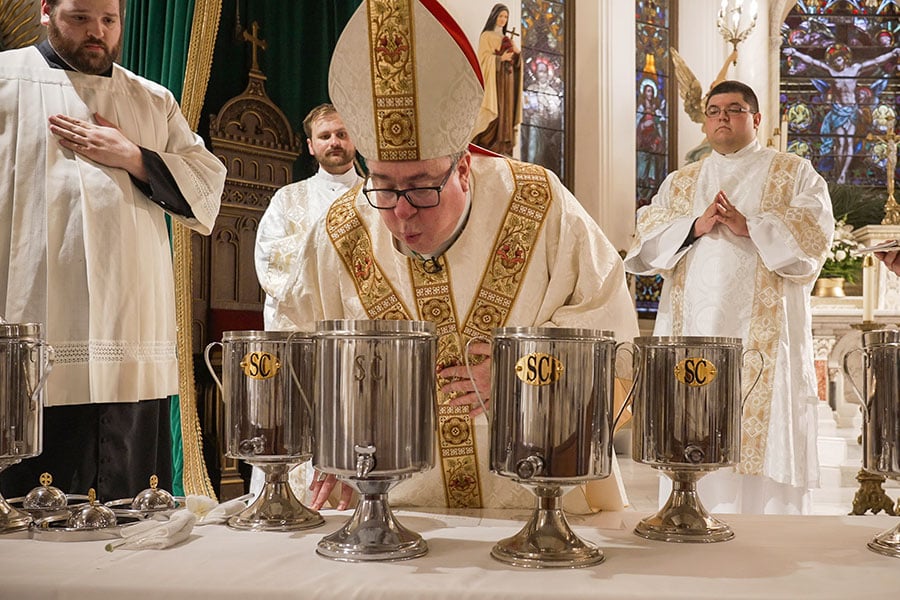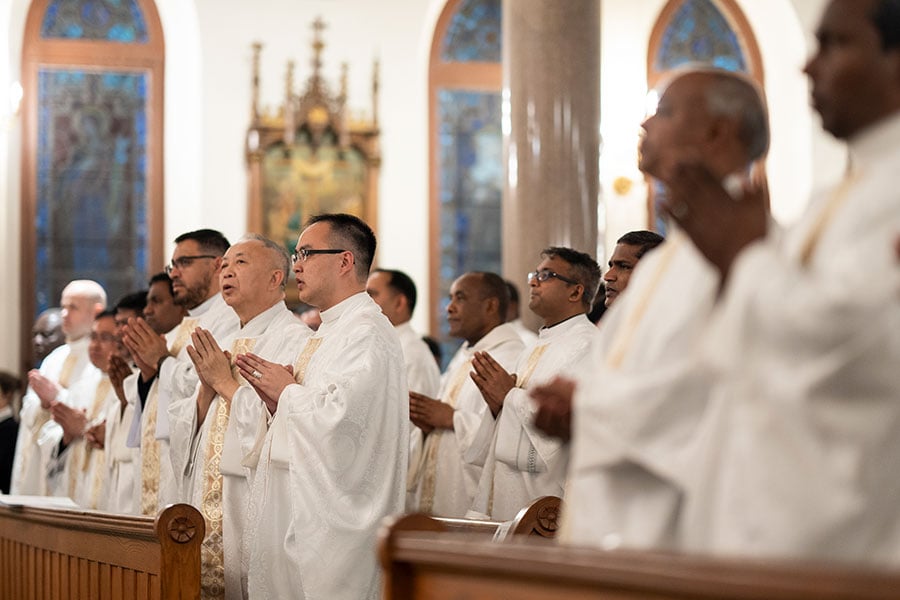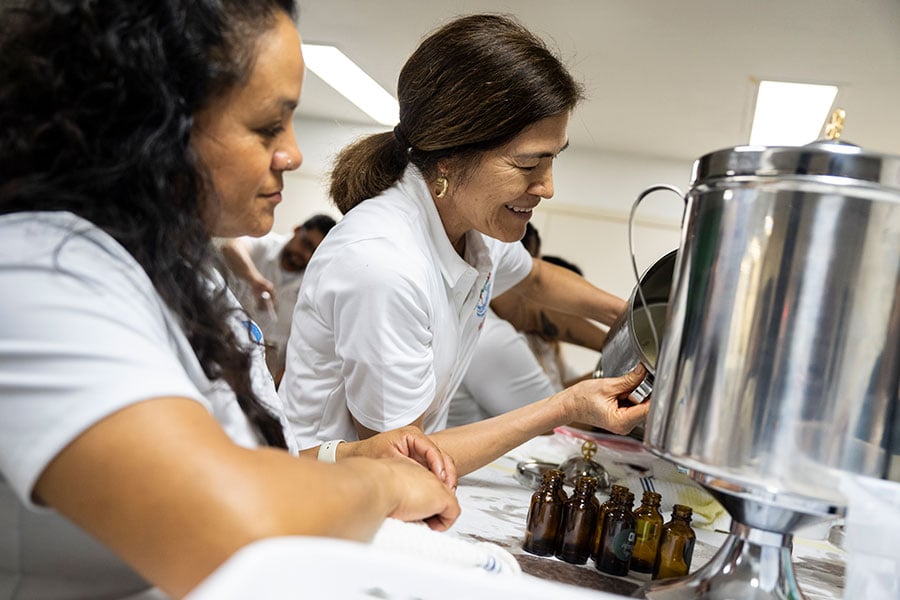One, Holy: blessing of oils and priestly vow renewal at Chrism Mass underscore unity of Catholic Church

Bishop Olson breathes into the sacred chrism to symbolize the Holy Spirit at the Chrism Mass on April 4, 2023, at St. Patrick Cathedral. (NTC/Juan Guajardo)
Photos from the 2023 Chrism Mass
Tuesday of Holy Week marks the date of the annual diocesan Chrism Mass, which includes the act of priests within the diocese renewing their vows.
Other dioceses throughout the world will do the same on or near that day.
It’s a Mass many Catholics never experience, or in some cases are unaware of, but also one that’s essential to the faith and a wonderful underscore of the unity of the Catholic Church.
“I think it’s a beautiful way that the Catholic Church extends the reach of the bishops into all the parishes, and people, of their dioceses,” said Andrea Woolums, DRE of Argyle’s St. Mark Parish. “It exemplifies the bishop’s role as shepherd of the diocese in that way.”
During the Chrism Mass, Bishop Michael Olson will bless the sacramental oils to be used throughout the diocese in the coming year. The oils, once blessed, will be distributed to the individual parishes.
The blessed oils — oil of the catechumens, oil of the sick, and chrism oil — play an essential role in bestowing grace in sacramental rites. The use of oils for anointing dates to ancient times.
The oil of catechumens is used to anoint those being baptized and lends strength to renounce sin to those being baptized.
The oil of the sick represents Christ’s accompaniment to persons sick or dying.

Linked to sanctification, the chrism oil is used for baptism, confirmation, and holy orders to impart an indelible sacramental character. The bishop also pours chrism oil on the altar and walls when dedicating a new church.
In holy orders, the chrism oil is used to consecrate the hands of priests, making them Christ’s hands in the world, and to anoint the head of the bishop.
“Three oils for different purposes,” said Father Thu Nguyen, diocesan director of Liturgy and Worship. “All three oils are the same, extra virgin olive oil, but for the chrism we add balsam, the fragrance, into that.”
Much preparation
The Chrism Mass is an endeavor exacting and labor intensive, with much of the preparation falling upon Fr. Nguyen’s shoulders.
“When it comes to liturgy and worship, the Chrism Mass is one of the major celebrations of the Church in preparing for the liturgical year,” Fr. Nguyen said. “My role is to prepare the whole liturgy and find liturgical ministers to serve in that Mass.”
That’s not all.
“The oils involved are not just a few gallons but a whole lot, because we have to distribute them to 92 parishes,” Fr. Nguyen said. “So, one of the first responsibilities for me involves preparing the oil stock. I just sent a letter to all the priests to get the oil amount requests for their parish for the year so I know how much oil to buy to be consecrated and blessed during the Chrism Mass.”
Boxes and other supplies must be secured as well to ensure the oils are ready for distribution to the individual priests immediately following the Chrism Mass.
“Those are the major things,” Fr. Nguyen said. “Also, liturgical ministers have to be found to carry the oils to present to [Bishop Olson]. Then music has to be prepared as well as worship aids and programs.”
Begin anew
Once Bishop Olson consecrates and blesses the new oils, oil left from the previous liturgical year can no longer be used.
Which raises the question of what becomes of the old oil.

“The old oil is not to be destroyed or thrown away,” Fr. Nguyen said. “Parishes usually have oil left over from the previous year. With that, they can burn it during the Easter Vigil fire, which is recommended. Or they can bury it.”
Vows renewed
Following the blessing of the oils, priests in attendance will stand to renew their ordination vows, thus recommitting themselves to serving God and His people.
“I think that’s so cool,” Woolums said. “That’s something so wonderful and important, but probably something a lot of people don’t know about. I think it’s something more people need to know about and definitely something worth experiencing.”
St. Mark Coordinator of Sacramental Preparation Joy Medley agreed.
“I think so many people aren’t aware that priests renew their vows during the Chrism Mass,” Medley said. “That’s beautiful and, in and of itself, worth seeing. Most of us didn’t get to see our parish priest get ordained so, to see them renew their vows, that would be a gift.”
Woolums and Medley joined Fr. Nguyen in calling the importance of both the blessing of the oils and renewal of priestly vows as examples, both concrete and symbolic, of the unity of the Church.
“It’s amazing when you think that this is happening not only within our diocese and with our priests but also everywhere else all over the world throughout the Church,” Woolums said.
Although the Chrism Mass is less known, overshadowed perhaps by Holy Week activities, the celebration is important and worth attending, Fr. Nguyen said.
“The Mass tends to be mostly priests, religious, and their family members,” Fr. Nguyen said. “Sometimes high school or confirmation students. But the Mass is open to the public. They’re welcome, and encouraged to take part.”
The Chrism Mass will be held at 6 p.m. on Tuesday, March 26 at St. Patrick Cathedral.
